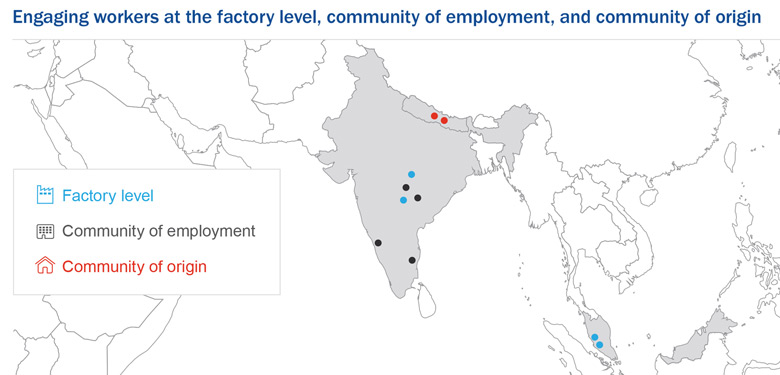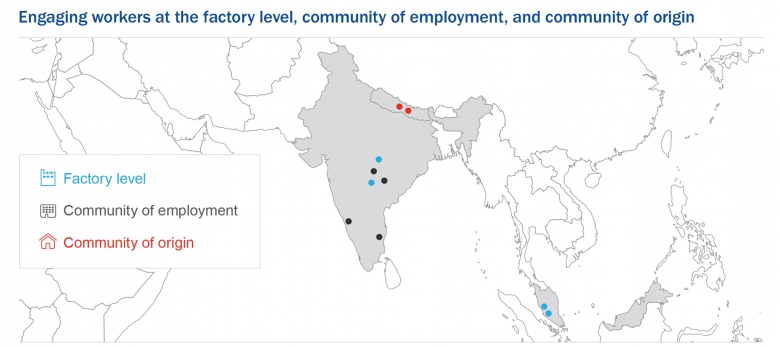
Journey of the migrant worker – New approaches for detecting risk of forced labour across the business value chain
The International Labor Organization (ILO) defines forced labour as referring to situations in which persons are coerced to work through the use of violence or intimidation, or by more subtle means such as accumulated debt, retention of identity papers or threats of denunciation to immigration authorities.
In their recent publication “Global Estimates of Modern Slavery: Labour and Forced Marriage”, the ILO and Walk Free Foundationestimate 16 million people are in forced labor in the private economy worldwide. Half of these men and women are in debt bondage, working to repay a debt that they have no hope of repaying. This report also showed that for forced labour specifically, the prevalence is highest in Asia – Pacific, with victims of this practice representing four out of every 1,000 people.
With such prevalence of these practices in the private economy, companies are increasingly expected to assess, mitigate and prevent forced labor throughout their business activities:
- Increased legislation: Since the UK passed the Modern Slavery Act in 2015, France has also followed suit with their ‘Duty of Vigilance’ law 2017. There have even been discussions for a similar Act in Hong Kong. More recently, the Australian Parliament joined this movement with the launch of an inquiry into establishing a Modern Slavery Act in Australia.
- Demand for transparency in supply chains: A concern raised mostly by advocacy groups, there are also growing calls from the investment community in their analysis of environmental, social, and governance (ESG) risks and in tracking companies’ responses to emerging regulations. Stricter procurement practices are also being seen from corporate customers looking to ensure their own ethical sourcing.
These developments are placing companies under intensifying pressure to have visibility throughout their supply chains, to understand the risks of forced labour, and to act should these practices be discovered. However, most companies lack effective means to take these steps across all supply chain levels.
Journey of migrant workers
Migrant workers may be a vulnerable group to forced labour, with certain cohorts at greater risk of exploitation. But to understand the issues, we need to understand the journey of the workers. Migrants traveling both across international borders as well as within their country’s borders are vulnerable to exploitative practices.

Worker engagement and communication is important at every step of this journey to:
- Assess forced labour risk by identifying the number of workers likely working under forced labour conditions,
- Identify key drivers of forced labour risk to better understand root causes that lead to a risk of forced labour, and applying this to supply chain risk management and internal decision-making
- Inform worker education programs that aim to improve workers’ knowledge of human rights and exploitive recruitment techniques in effort to support safe and ethical migration
Typically, worker engagement has focused on the ‘employment’ step of the journey, and so risks associated with the other steps can be missed or under-represented. Businesses trying to identify these risks alone can also struggle to understand the local factors or to receive representative responses, and so partnership with NGOs or industry initiatives is vital to uncover the risks of forced labour in the business value chain.
New approaches to worker engagement
Laborlink by ELEVATE has developed a multi-site worker engagement strategy that leverages mobile surveys to anonymously connect with migrant workers at the factory level, and within their communities of employment and origin. This multi-site approach is fundamental in identifying the risks associated with each stage in the journey of the migrant workers, and in surfacing any hidden issues within supply chains. The questions asked during these surveys are designed to align with the International Labor Organization’s (ILO) Hard to See, Harder to Count survey guidelines.

Key learnings from this approach to worker engagement have been published by Laborlink in a new Forced Labor Report, with example case studies gathered from a variety of programs that leveraged worker surveys as the factory level, and within the communities of employment and origin.
In total, worker surveys as part of this approach have been deployed at 50 community and factory sites across India and Nepal, with expansion planned to at least 30 sites in Malaysia in 2018. Key clients include Target, Vodafone, and Amnesty International.

Key learnings from these worker surveys include:
- New insights: Survey analysis identifies key drivers of forced labor and numbers of workers at risk, which enables clients to prioritize preventative actions for eliminating forced labor.
- Community-based survey methodology: To better understand the community conditions that lead to labor migration, Laborlink implements community-based surveying to collect complementary and granular information at the local level.
- Local NGO partnerships: Laborlink shares survey findings with suppliers and local NGOs in effort to take a collaborative approach towards understanding and mitigating the risk of forced labor. Providing NGOs with data helps to better understand why workers leave rural communities, and to identify the vulnerabilities that exist, equipping the NGOs to customize programming around given issues. NGOs can also partner with businesses to conduct educational trainings, which are informed by the knowledge received through survey analysis.
- Act and report: With this new data and worker insight, companies can inform their internal decision-making on new risks, increase transparency to external stakeholders, and expand supplier training around awareness of modern slavery.
What this means for businesses
As the requirements for supply chain transparency continue to grow globally, the conversation around migrant workers and forced labour risk is set to continue, particularly in Asia. The development of such new techniques and approaches to worker engagement are essential for businesses to be able to effectively tackle the increasing requirements for visibility in supply chains, as well as for better detection of forced labour risk across suppliers for internal decision-making and ethical sourcing.
—————————
Our thanks go to David Koller, Communications and Marketing Manager at Laborlink by ELEVATE, for contributing to this article.
| Laborlink by ELEVATE is a mobile platform that establishes a two-way communication channel for workers to share their viewpoints in real-time, and for organizations to have clear visibility of worker well-being in their supply chains. Since 2010, Laborlink technology has been deployed in 16 countries and has reached over 1,000,000 workers worldwide. | ||
|
|
|
|
| The Responsible Business Alliance (RBA) and Programs in Southeast Asia Supported by Walmart Foundation, the RBA Foundation and ELEVATE will implement Responsible Workplace and Responsible Recruitment Programs in Malaysia in 2018 across a variety of industries. Building on the success of the previous Workplace of Choice pilot, the Responsible Workplace program focuses on improving workers’ awareness of their labor rights, developing worker-management communication and amplifying workers’ voices to improve working conditions and mitigate issues that contribute to forced labor. Program elements include Laborlink surveys, helpline, worker-management communications and worker education. For questions regarding RBA program, please contact Melissa Caraher at mcaraher@elevatelimited.com |
||